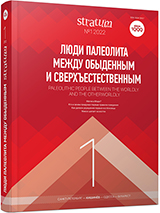«Тонкие» листовидные бифасы начала верхнего палеолита Алтая: технология, формообразование и каменное сырье
Initial and Early Upper Palaeolithic “Thin” Leaf-shaped Bifaces: Technology, Shaping and Stone Raw Material
Author(s): Natalia E. Belousova, Anton M. Rodionov, Andrey V. Vishnevskiy, Alexander Yu. Fedorchenko, Valeria A. Mikhienko, Maxim V. SeletskiySubject(s): Archaeology, ICT Information and Communications Technologies, Prehistory
Published by: Издательский дом Stratum, Университет «Высшая антропологическая школа»
Keywords: Altai Mountains; Initial and Early Upper Palaeolithic; leafshaped bifaces; raw materials; experimental knapping; technological analysis; 3D-modeling;
Summary/Abstract: The tradition of producing bifacial leafshaped points in Altai demonstrates a relationship with the culture and life support strategies of its earliest Upper Palaeolithic inhabitants. Here we present the reconstruction of bifacial technologies, based on the study of published data and archaeological collections, the latest results of geological and mineralogical data and experiments. The application of the well-known techniques of processing thin flint bifaces characteristic of the Russian Plain to the raw materials of Altai and to the local canons of producing bifacial tools makes it possible to reveal a number of factors that have a considerable effect on the morphology of the bifacial end products. We concluded that the transition from the massive Middle Palaeolithic bifaces to the thin and symmetrical leafshaped forms of the Initial and Early Upper Palaeolithic was associated with changes in stone processing. We found that the peculiarities of the Altai raw materials with their specific consumer characteristics and a high level of petrographic diversity did not exert much influence on the techniques of biface manufacture, but had a profound effect on the process of secondary thinning. As a result, the finished products turned out to be more massive than those made of flint. The results of the study confirm the need for a flexible approach to understanding the term “thin” biface.
Journal: Stratum plus. Археология и культурная антропология
- Issue Year: 2022
- Issue No: 1
- Page Range: 329-353
- Page Count: 25
- Language: Russian
- Content File-PDF

